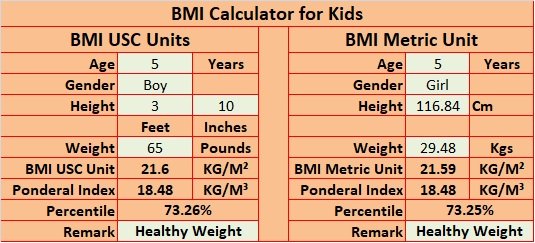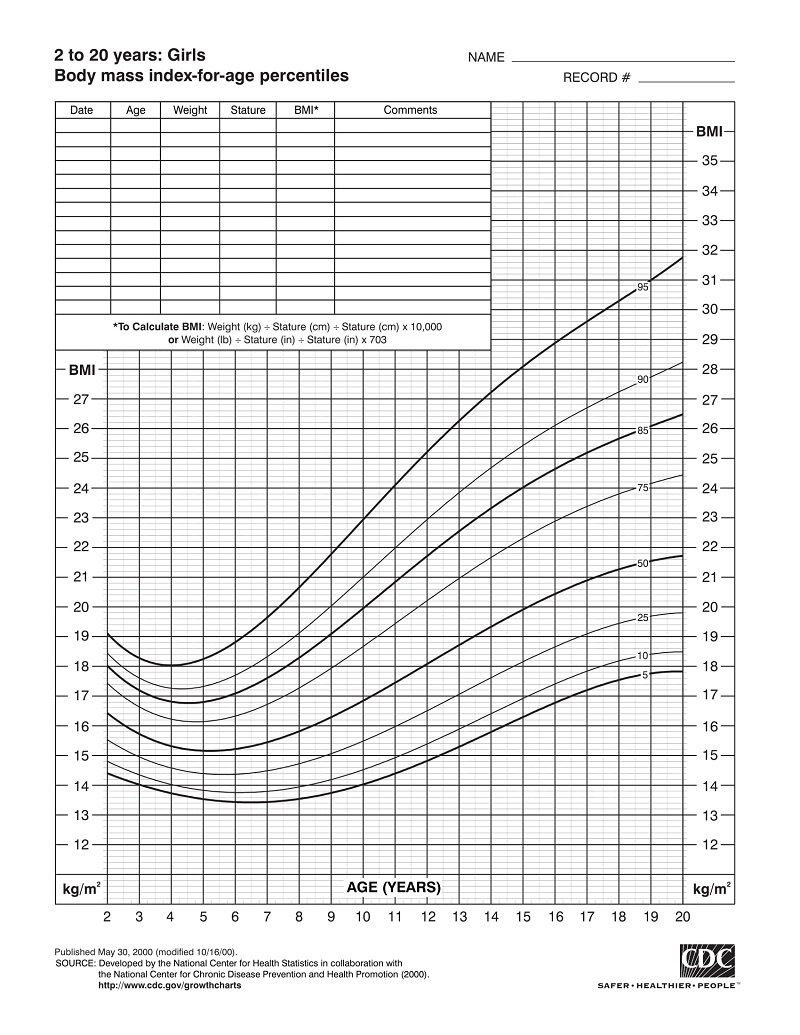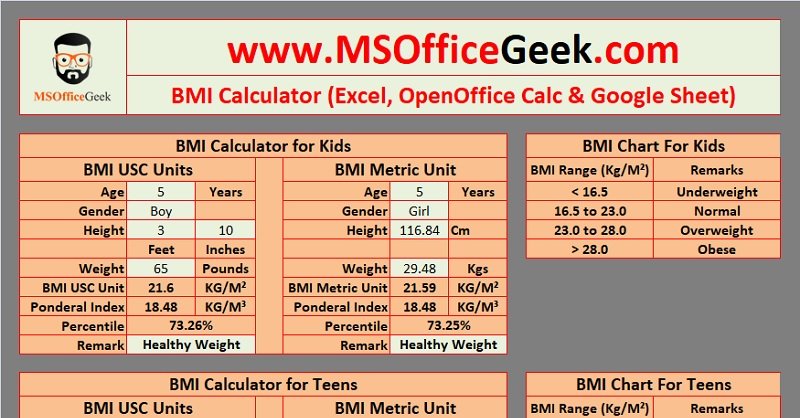[tta_listen_btn btn_text=”Listen to this Article”]
Ready-to-use BMI Calculator in Excel, OpenOffice Calc, and Google Sheets to find Body Mass Index for kids, teens, and adults in a few clicks.
Download the template and insert the data in the required fields. The template automatically calculates the Body Mass Index and Ponderal Index. Moreover, it also consists of an online calculator by the Center for Disease Control and Prevention.
This article will help you understand the Body Mass Index in detail for different ages and their normal BMI range.
Table of Contents
Download BMI Calculator (Excel, OpenOffice Calc, Google Sheet)

We have created a simple and easy BMI calculator with predefined formulas to calculate Body Mass Index and Ponderal Index.
Just select the age from the dropdown list and insert the individual’s height and weight. It will automatically calculate the BMI and PI for kids, teens, men, and women.
Additionally, you can also download other templates like Accounts Payable Template, Accounts Receivable Template, Payroll Template With Attendance, and Employee Salary Sheet.
Feel free to contact us for the customization of this template as per your requirements. We also design new templates based on your needs. You can hire us for our services on Fiverr or directly contact us at info@msofficegeek.com.
BMI Calculator (Adults)
Online BMI Calculator By Center for Diseases Control and Prevention. Use this calculator for adults above age 20.
Just insert the height and weight of the individual and press the “Calculate” button.
BMI Calculator (Child & Teens)
Online BMI Calculator By Center for Diseases Control and Prevention. Use this calculator for children and teens between the ages of 2-20.
What is BMI?
BMI stands for Body Mass Index. BMI is the measurement to evaluate the fat proportion of an individual based on their height and weight. In simple terms, it is an indicator of an individual’s total body fat.
BMI simply defines whether an individual is underweight, healthy, overweight, or obese. After multiple studies, scientists have developed charts that define the normal range based on the category of individual.
Moreover, the normal range for children, teens, men, and women is respectively different. A BMI higher than the normal range leads to overweight or obese whereas a BMI below the normal range defines underweight.
Furthermore, a higher Body Mass Index indicates higher levels of body fat whereas a lower Body Mass Index indicates lower body fat in an individual.
Health Risks for Individuals Having Higher BMI
- Higher cholesterol results in heart stroke.
- Risk of developing or exaggerating diabetes.
- Increases risk of high blood pressure levels.
- Also results in gallbladder diseases and arthritis.
Health Risks for Individuals Having Lower BMI
- An underweight individual develops a lower immune system which results in a higher risk of diseases.
- Being underweight can also result in complications in surgeries.
- Risk of infertility in women.
- Prone to have low bone mineral density resulting in bone complications and osteoporosis.
Formula To Calculate BMI
BMI can be calculated in two ways: using the US customary system (USC) and using the International System of Units (SI). SI is also known as a Metric Unit.
USC Units BMI Formula
USC unit BMI formula uses pounds(lbs) as mass and inches in height. Divide Mass(lbs) by height squared and multiply by 703. The BMI results are displayed by kg/m².
BMI = 703 X Mass(lbs) / Height² (in)
If you have height in feet and inches then convert them by multiplying the feet by 12. A foot consists of 12 inches. For example, if the height is 4 feet 3 inches then it will be (4 X 12) + 3 = (48 + 3) = 51 inches.
If you have height in centimeters then convert them by dividing the inches by 2.54. A centimeter consists of 0.39 inches. For example, if the height is 150 centimeters then convert it by dividing (150/2.54) = 59.05 inches.
If you have height in meters then convert them by multiplying the inches by 39.37. A meter consists of 39.37 inches. For example, if the height is 1.53 centimeters then convert it by dividing (1.53 X 39.37) = 60.24 inches.
Metric Units BMI Formula
The Metric formula uses kilograms as mass and meters in height. Divide Mass (kgs) by height squared. The BMI results are displayed by kg/m².
BMI = Mass (kgs) / Height² (m)
What Is the Ponderal Index?
Ponderal Index or Corpulence Index is the measurement to evaluate the leanness of an individual. It was first proposed by a Swiss physician, Fritz Rohrer in 1921.
It is similar to BMI but the mass is normalized with a cube of height instead of a square of height. The Ponderal Index is more authentic than BMI as it yields proper results for extremely short or tall persons. Due to this, it is most commonly used in pediatrics.
Ponderal Index plays an important role in identifying symmetrical or asymmetrical intrauterine growth restriction in a child. The ponderal index has more significance than BMI, especially in infants.
Formula To Calculate Ponderal Index
Similar to BMI, the Ponderal Index (PI) can also be calculated in two ways: using the US customary system (USC) and using the International System of Units (SI). SI is also known as a Metric Unit.
USC Units PI Formula
USC unit PI formula uses pounds(lbs) as mass and inches in height. Divide the height by the cube root of Mass(lbs). The PI results are displayed by kg/m³.
PI = Height (in) / Mass(lbs) X 1/3
Convert the height in inches using a converter.
Metric Units PI Formula
The Metric formula uses kilograms as mass and meters in height. Divide Mass (kgs) by height cube. The PI results are displayed by kg/m².
BMI = Mass (kgs) / Height³ (m)
Convert the height in meters using a converter.
Important Note: This BMI calculator is a general evaluator and not for clinical guidance. Kindly, consider advice from your healthcare providers on healthy weight status.
BMI Calculator For Kids

We have created a simple BMI calculator for kids using both USC units and Metric units.
BMI (Kids)- USC Units
Select the age between 2-12 for kids from the dropdown list, and insert height in feet and inches, and weight in pounds. The cells consist of predefined formulas and automatically calculate BMI, PI, and Percentile for you using the USC units formula.
BMI (Kids)- Metric Units
Select the age between 2-12 for kids from the dropdown list, and insert height in centimeters, and weight in kilograms. The cells consist of predefined formulas and automatically calculate BMI, PI, and Percentile for you using the Metric units formula.
Moreover, the template displays a remark for the derived BMI. If the BMI is in the normal range then it displays “Healthy Weight”. If the BMI is below the normal range then it displays “Underweight” and if it is above the normal range then it displays “Obese”.
Normal BMI Chart for Kids
Compare your child’s BMI with the BMI chart given below:

BMI Calculator For Teens

Here is a BMI calculator for teens using both USC units and Metric units.
BMI (Teens)- USC Units
Select the age between 13-20 for teens from the dropdown list, and insert height in feet and inches, and weight in pounds. The cells consist of predefined formulas and automatically calculate BMI, PI, and Percentile for your teen using the USC units formula.
BMI (Teens)- Metric Units
Select the age between 13-20 for teens from the dropdown list, and insert height in centimeters, and weight in kilograms. The cells consist of predefined formulas and automatically calculate BMI, PI, and Percentile for you using the Metric units formula.
Additionally, the template displays a remark for the derived BMI. If the BMI is in the normal range then it displays “Healthy Weight”. If the BMI is below the normal range then it displays “Underweight” and if it is above the normal range then it displays “Obese”.
Normal BMI Chart for Teens
Compare your teen’s BMI with the BMI chart given below:

How To Measure Healthy BMI in Kids and Teens?
Children from ages 2-20 require a different standard of evaluation. First, measure the BMI and then use it to determine the percentile in which your child falls among children of the same sex and age group. Use this percentile value to determine whether your child is underweight, normal, overweight, or obese.
Children with a BMI of less than the 5th percentile are considered underweight. Kids with BMI from the 5th percentile to below the 85th percentile are considered normal.
Whereas children with BMI between 85th – 95th percentile are considered Overweight and children having BMI greater than or equal to the 95th percentile are obese.
BMI Percentile Chart for Boys (Age 2 – 20)

Source: www.cdc.gov
BMI Percentile Chart for Girls (Age 2 – 20)

Source: www.cdc.gov
BMI Calculator For Men

The BMI ranges for kids and teens from ages 2-20 is different from adults above 20. Hence, the normal range of BMI of adults differs from kids and teens.
BMI (Men) – USC Units
Insert age between 21-100, insert height in feet and inches, and weight in pounds to derive BMI for men using USC units. The cells consist of predefined formulas and automatically calculate the Body Mass Index and Ponderal Index for Adult Men using the USC units formula.
BMI (Men) – Metric Units
Similar to the above section, insert age between 21-100, height in centimeters or meters, and weight in kilograms to derive BMI for adult men. The cells consist of predefined formulas and automatically calculate the Body Mass Index and Ponderal Index for adult men using the Metric units formula.
Normal BMI Chart for Men
See the normal body weight chart given below to know in which range your BMI falls.

BMI Calculator For Women

In the end, there is this BMI calculator for women. Similar to the above, we have created this calculator using both USC units and Metric units.
BMI (Women) – USC Units
Insert the following 3 fields:
- Age between 21-100
- Height in feet and inches
- Weight in pounds
The cells consist of predefined formulas and automatically calculate the Body Mass Index and Ponderal Index for Adult Men using the USC units formula.
BMI (Women) – Metric Units
Similar to the above section, insert the following 3 fields:
- Age between 21-100
- Height in centimeters
- Weight in kilograms
The cells consist of predefined formulas and automatically calculate the Body Mass Index and Ponderal Index for adult men using the Metric units formula.
Normal BMI Chart for Women
The normal body weight chart is given below. See which range your BMI falls in.

Difference Between Male and Female BMI
According to the research conducted by the Centers for Disease Control and Prevention and WHO, there is no difference between male and female BMI.
However, researches show a slight difference in male and female BMI. Males are heavier than women and comparatively, have higher BMI values.
Based on these researches, differences between the genders need to be taken into consideration for planning interventional programs to prevent obesity.
Uses of BMI
Generally, BMI calculations are used by health professionals to screen their overweight and obese patients. it helps them identify the health risks of the patients. Eventually, it helps them to prescribe medicine or guide physical activities to their patients.
Currently, fitness instructors and gym professionals also look for the BMI of their clients to identify and design workouts for their clients. Nowadays, people are more health-conscious than before.
Advantages of Measuring BMI
- Helps to monitor your body fat proportion.
- Regular monitoring prevents chronic diseases like diabetes, stroke, etc.
- It is an inexpensive way to monitor body fat levels and can be easily done at home.
Limitation of BMI
- BMI measures general body fat level. BMI of the same age and height can vary based on their body type. A muscular individual will have the same BMI as someone with overweight.
- The proportion of body fat, muscles, and bones varies with age. This is common among females. Usually, an old woman in her mid-sixties weighing the same as she did at 25 years of age has a larger amount of fat. BMI fails to calculate that and puts her in the healthy BMI range.
- According to the National Academy of Sports and Medicine, the body mass index is merely a ratio of weight to height. Therefore, it does not take body composition into account. This means that this assessment does not account for whether your weight is predominantly fat or muscle.
- As per the Academy of Nutrition and Dietetics, BMI does not directly measure body fat. As a result, some people, such as athletes, may have a BMI that identifies them as overweight even though they do not have excess body fat.
Frequently Asked Questions
If you like this article, kindly share it on different social media platforms so that your friends and colleagues can also benefit from the same. Sharing is Caring.
Please send us your queries or suggestions in the comment section below. We will be more than happy to assist you.

